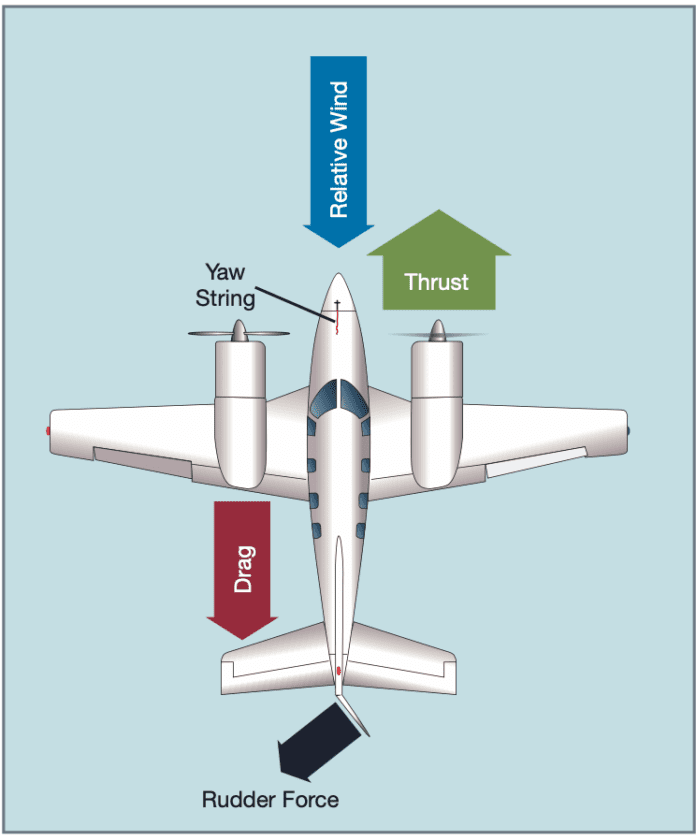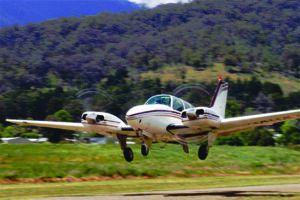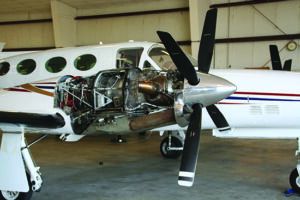
I’m a big believer in “chair flying.” The best chair is the pilot’s seat of the aircraft you’re learning, with the engine or engines stopped and external electrical power. As a helicopter student, I spent many happy hours sitting in the hangared Robinson, practicing autorotations, a maneuver I found really difficult. Hold your hand like this. Look here. Now look here. Move your hand here. That kind of thing. The maneuver got a lot easier after chair-flying it.
Developing those motor skills and hand/eye coordination doesn’t have to be done while the engines are running, however. Even professional baseball players use tees to practice hitting balls pitched to certain locations.
I got my multi-engine rating in 1995, and ever since then, every time I have driven to the airport I have rehearsed what to do for an engine failure on takeoff. Every time. Once, at one of the big-name simulator schools, I got lazy and showed up the first day without rehearsing. I couldn’t handle the “V1 cuts,” when an engine fails right at decision speed. The instructor hinted I’d need remedial training. Over lunch, I chair-flew the maneuver a dozen times, and the afternoon session went smoothly.
Every time.
Practice, Practice, Practice
As I approach the airport and remember to practice I go through the multi-engine pilot’s holy trinity: Identify. Verify. Feather. In the car, one leg (usually the right, on the gas pedal) is ahead of the other. “Engine failure.” The memorized checklist kicks in. I do the physical motions and move my eyes to the right spots. “Working foot, working engine” is one mantra. “Dead foot, dead engine” is another. That’s the identification part.
I then reach up to where the throttle or power lever would be and reduce the power on what I think is the dead engine. Constant-speed props keep the rpm the same, for a while, so I look where the appropriate power gauge would be. I also note that there is no change to how much pedal it takes to stay straight.
That’s the verification part.
I finally reach where the propeller lever would be and go through the physical motion of feathering the prop and securing the engine. This varies from airplane type to airplane type. Sometimes the pilot has to move the prop lever over a gate, or through some kind of stop. I do that motion.
Every time.
Y Is For Yaw
The first multi-engine airplane I flew a lot was a Piper Seneca II. Its turbocharged engines generated a lot of thrust, even at high altitude, which was good because the field elevation was above 4000 feet msl, with summer density altitudes above 8000.
One Seneca quirk is that, even though I’m a skinny guy, I can barely fit between the prop and the fuselage while doing a preflight inspection. But that’s good, too. It means that the engine forces of thrust and drag happen close to the airplane’s centerline.
Remember, torque is the tendency to turn around an axis. It’s the product of force and arm. Arm is the distance from the source to the axis, in this case the yaw axis. The Seneca engines have a lot of force but as little arm as possible, reducing the tendency of the airplane to yaw.
Yaw? Each engine’s thrust produces yaw. The drag of a windmilling propeller produces more yaw. A failed engine is a double-trouble source of yaw: thrust on one side, drag on the other. A feathered engine’s prop blades are essentially perpendicular to the airflow, reducing drag and therefore yaw. That’s why the identify/verify/feather sequence is so important, and why I practice it on the drive to the airport.
Every time.
The Seneca is unusual because its engines are counter-rotating—they turn in opposite directions, but most twins and even four-engine airplanes (C-130, P-3 Orion) have engines that all turn the same way. That’s a problem, because propellers don’t produce thrust evenly (see “Propeller Theory 101,” in Aviation Safety’s November 2022 issue). The downward blade, usually the right, produces more thrust than the upward blade. So, the thrust from an engine on the right has a larger arm than the thrust from an engine on the left. That’s why in most twins the critical engine—the one that causes the most problems when it fails—is the left one.

Flying a multi-engine airplane is different from commanding a single, for more reasons than just aerodynamics. Two engines generally means there’s more power available. There also may be more systems to deal with, and they’re likely to be more complicated. The twin likely also will be heavier than the airplane you’ve grown accustomed to. Let’s run through what that can mean.
- More power means things likely will happen faster in a twin when everything is running. That translates into better runway acceleration—though perhaps not shorter takeoff rolls—better climb performance, etc. It also means you have to get further ahead of the airplane, and stay there, versus when flying many singles.
- A heavier airplane can mean a better ride in bumpy air and greater tolerance for crosswinds. (Slightly twisting the throttles can help with crosswinds, too.) It also can mean higher runway speeds on takeoff and landing. One thing it definitely means is a different landing flare technique than in the Skyhawk you’ve been flogging. Pro tip: Carry more engine power into the flare than you normally would with a single.
- Systems complexity is another result of having a more-capable airplane. At a minimum, a twin’s fuel selector has crossfeed positions. Also, there’s likely a combustion heater and related controls to warm the cabin. Since the heater burns fuel, you’ll have less of it for the engines. — J.B.
The Problem With Yaw
The pilot’s primary yaw control is the rudder. An instructor gently reminds every primary student that active feet on the rudder pedals smooth out the effects of P-factor and adverse yaw.
The rudder acts an airfoil, and the aerodynamic force it produces is proportional to the square of speed. Full rudder at, say, 45 knots means one quarter of the force of full rudder at 90 knots. If a multi-engine airplane gets too slow, then the rudder is not strong enough to counteract the yaw that happens when an engine fails. The minimum speed that provides enough rudder is called minimum control speed, or VMC. It’s marked with a red radial line on the airspeed indicator, which represents VMC at a specified set of conditions. These don’t matter as much as the concept: If the airplane is too slow, it will start to yaw toward the dead engine. Even if full rudder stops the yaw, the pilot has to increase the airspeed by lowering the nose. So don’t get slow near the ground.
Yaw makes the outside wing go faster through the air and produce more lift, which makes the airplane roll toward the dead engine. That’s a VMC rollover, and it can happen very quickly. If it happens at takeoff, there is no room for error. That’s why rehearsing maintaining airspeed and the identify/verify/feather sequence is so crucial.
Every time.
What’s Old Is New
I haven’t flown a multi-engine airplane in a year or so, and I’m waiting to get checked out in a beautiful Piper Apache based at a nearby airport as soon it’s out of maintenance. It’s a comfortable airplane, not especially fast, but it has style. This one’s engines have had good maintenance, but they’re piston engines, so they are more likely to fail than a turbine. And if one fails on the first takeoff, I will have to be ready. A Vmc rollover close to the ground rarely offers second chances.
But I haven’t flown an Apache in years, and when I did it was mostly in the role of an MEI reminding the owner to put the landing gear down on short final. I’d like to instruct in this one, too. The regulations (FAR 61.195) require five hours of pilot-in-command time in-type to give instruction in a multi-engine airplane. It’s that old story about regulations: my logbook shows that I am legal, but I am not proficient enough to instruct in it. Yet.
So I’ll have to do some chair-flying. I hope that the FBO will let me sit in the airplane on the ramp and get to know it again, and practice putting my hands and eyes and brain where they need to be in as many situations as possible. Then, as I drive to the airport to fly it, I will rehearse the holy trinity of identify/verify/feather on the way there.
Every time.
(Another local FBO also has an Apache, but at its airport, takeoffs are generally uphill, toward trees. There’s a narrow gap in the trees. That’s too many adverse factors for my taste.)
Every time.

Turboprop engines, like the Pratt & Whitney Canada PT6 pictured at right on a Cessna Conquest, are amazing. They produce lots of thrust and are super-reliable. The downside is that on some flights they can burn a ton of fuel. Literally.
An unusual downside is that a turbine engine can’t really idle the same way a piston powerplant can. This is a problem if an engine fails close to minimum control airspeed, VMC. At VMC, the yaw moment from the working engine is stronger than the yaw moment from a fully deflected rudder. In a piston twin, a pilot with a VMC problem might regain control by reducing power on the working engine to idle. But a typical turboprop engine at flight idle still produces some thrust.
VMC is one of the big differences between singles and twins at low airspeed. In a single, yaw at low airspeed is a stall with a spin entry. Adding power may help. In a twin, though, it might be a VMC rollover and loss of control. Adding power makes the problem worse.
In all of these situations, the most important part of recovery is lowering the nose.
How Much Is Too Much?
I used to think that flying multi-engine airplanes was only safe if a pilot flies them often. When I flew hundreds of King Air hours every year, it was easy to preach that way, but that’s not possible right now. I’m not sure how much I need to fly that Apache to stay proficient; I’ll let you know. But in the meantime, I can sit at my desk and identify/verify/feather as often as possible. And on the way to the airport?
Every time. Θ
Jim Wolper is an airline transport pilot and retired mathematics professor. He’s also a CFI with single-engine, multi-engine, instrument and glider ratings.



